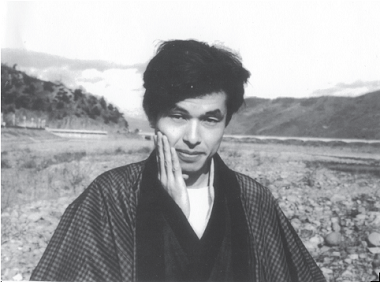BIOTEC Information
- 2022/04/12Mr.Takemoto Tadao, commemorating the lecture meeting, publishes [Chikuma-gawa no hotori-nite ̶ Nijyu-sai-dai Shisaku-note (At the Riverbank of Chikuma-Poetry-note of his Twenties)] (Benseisha Shuppan) at the end of April.

[Chikuma-gawa no hotori-nite ̶ Nijyu-sai-dai Shisaku-note]
(published by Benseisha Shuppan, ¥2,000 (anticipate price excluding tax). ISBN: 978-4-585-39509-6, 192 pages)This time, commemorating the lecture meeting by Mr. Takemoto Tadao who published a voluminous great work of [Michi-yori no Bara (Rose from the Unknown)] in 8 volumes (Benseisha Shuppan), on Apr.23, titled “ Rekishi to Vision ̶ [Michi-yori no Bara o kaki-oete (History and Vision ̶ Completed Writing [Rose from the Unknown)]” (at Rinri Institute of Ethics), he has organized 3 notebooks of his poems and comments on art written in his twenties into [Chikuma-gawa no Hotori-nite (At the Riverbank of Chikuma)] will be announced・published (scheduled to be sold in bookstores in late April). This book is in a form of a rare essay・poem collection, and it pours out the heart and mind of a young literary aspirant who lives embracing poetry in his heart, and it is a composed document of the agony of “Seishun (Youth),” which could already be referred to as mythological in the present days. What is to live in the society without abandoning one’s dream? What is the meaning of composing poetry? Sincere inquiry of a young man vibrates in our heart.
Mr. Takemoto, taking the opportunity of completed writing [Michi yori no Bara], has traced his own past – starting point, and sought out the meaning of the beginning and the end of the work, and at the time when continuing experimental thoughts, he discovered poetry notebooks of those days. In reading them over again, he found out that what he seeks after is the same in those days and now. It was as though Marcel Proust wrote [Le Temps retrouvé (Time Regained)] after writing [À la recherche du Temps Perdu (In Search of Lost Time)] –.
It is an artistic work full of beautiful words, and what is to live embracing the soul of the poet in the real-world is being depicted. In the book, jewel of 12 poems he composed in his twenties are printed, and they were printed in a poem-collection [CONCERTO] (Shichosha), which is presently out-of-print and difficult to obtain. It is a volume possible to trace the agony of youth until the poem was completed, and the process of its creative activities.
“[Michiyori no Bara] no saki de matsu mono wa, jikan o i-kaiten shite, waga seishun-fu de atta. ( What awaited beyond [Rose from the Unknown], was revolving the time once, and it turned out to be the record of my youth.)] – [Chikuma-gawa no hotori-nite (At the Riverbank of Chikuma)] ―― from the author’s preface
 At riverbed of Shinshu, Kamiyamada, Chikuma-gawa. 1960, 28 years old.
At riverbed of Shinshu, Kamiyamada, Chikuma-gawa. 1960, 28 years old.
Furthermore, the debut in [Chikuma-gawa no Hotori-nite] ! Mr. Takemoto Sadao’s maiden poem “Shuntei (Spring Riverbank)] written in his twenties is also inserted. It is a free and fresh poem which reminds us of Arthur Rimbaud’s “Sensation.” We would like to introduce a quotation from the extraction of the book-band.
Kawa-yo, hitosuji ni shiroku hikarite, nare wa chihei no hate ni kiyuru ka ni miyu, shiroku hikaru sono minamo o miyureba, makoto, waga urei wa kiete hatsuru ya (Oh, River shining white in a single stretch, You look as though disappearing beyond the horizon, Gazing at the shining white water-surface, Indeed, My sorrow vanishes away.) ――From the maiden-poem “Shun-tei (Spring Riverbank),” the debut in this book.
At the end of the book, an essay titled “Ushinawareta Shijin o motomete (In Search of Lost Poet), ” tracing the footsteps of the young poet is contributed by Misaki Abe, Principal curator of Shigyo Sosyu Collection / Memorial Gallery of Toshima Yasumasa.
Shigyo Sosyu Book-band Recommendation:
“Wakaki shijin no, kono akogare o miyo! Chosha no motsu Poesy wa, gendai no Nihon o utsu-daro. Tamashii no Seijyun ga, furuete-iru. (Look at the Adoration of the young Poet! The Poesy author possesses shall Strike the present Japan. Purity of the Soul is trembling.” ――― Shigyo SosyuAuthor Profile:
Takemoto Tadao (1932- ). Literary critic. Engaged in the creative activities both in Japan and France, mainly in the Cultural Exchange between the East and the West for a long period of time. Especially contributed to the in-depth mutual understanding by fatally tying André Malraux with the Japanese Spirituality, and introducing French translation of the poems of Empress Michiko. Major works are [The Empress Michiko Inori no Miuta (Poetry of Prayers)], [Paris Yugoku-ki (Paris Patriot Death Anniversary)], [Nostradamus Code], Poem collection [CONCERTO], and published in 2021 (Reiwa 3) autobiographic literary work [Michi yori no Bara (Rose from the Unknown)] in eight volumes from Bensei Shuppan. At the same time, he advocated Nihon Bunka Boei-sen (Japanese Culture Defense Line) against intolerable anti-Japanese media, and actively involved in the first line, solitarily, half his lifetime.[Contents]
Chikuma-gawa no Hotori-nite (Riverbank of Chikuma) (Takemoto Tadao)
Note I At the Riverbank of Chikuma
Note II Ten-years of Poem Composition
Note III Literary Fragment for Poem CompositionIn Seach of Lost Poet―― Contribution: Abe Misaki
Contributor Profile:
Abe Misaki (1980- )
Graduated from European and American Studies Spanish Faculty Linguistics Course. Obtained Spanish Language Superior Degree (D.E.L.E superior).
Presently Principal curator of Shigyo Sosyu Collection / Memorial Gallery of Toshima Yasumasa. Translation [The Christ of Velázquez] published celebrating the 150 th Anniversary of the Establishment of Japan-Spain Diplomatic Relation, and the 800 th Anniversary of Foundation of the Salamaca University. (Written by Miguel de Unamuno, Translation supervised by Shigyo Sosyu, Hosei University Press).
